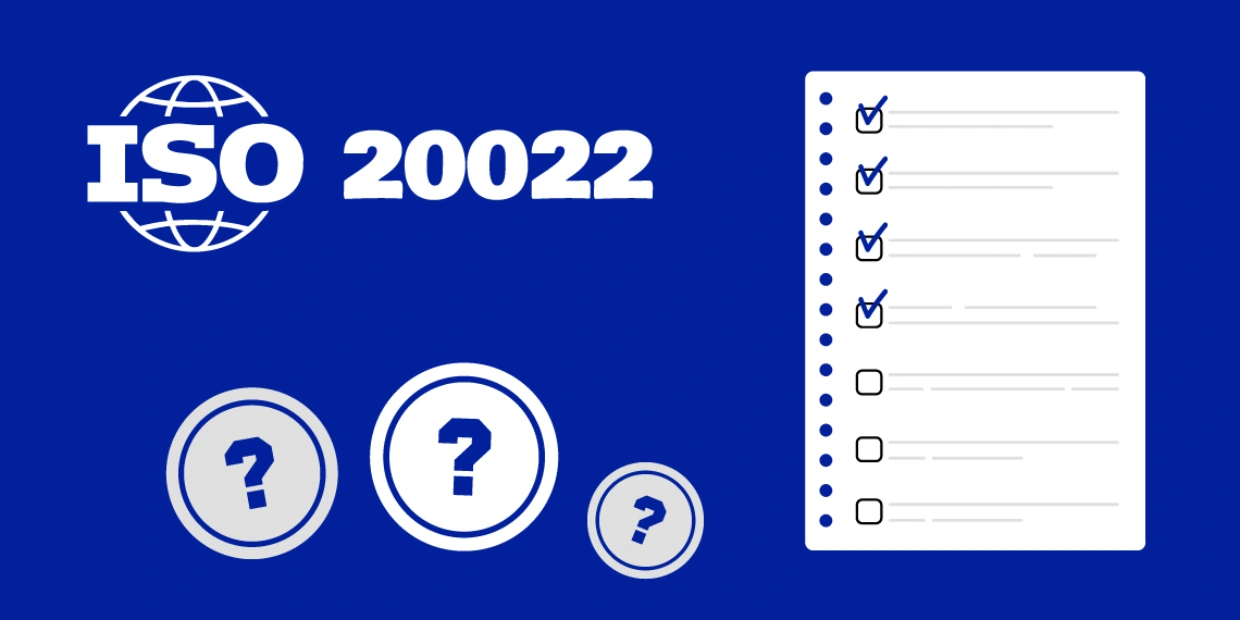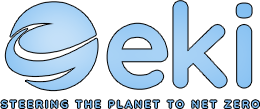
The ISO 20022 crypto-list — a light of conformity in the rapidly changing world of digital currencies. Imagine a world where cryptocurrencies are seamlessly integrated into the fabric of our financial institutions, fulfilling the exacting requirements established by the International Organization for Standardization (ISO) standards 20022. It’s more than just a fantasy; it's a definite reality of horizons.
Welcome to the era of ISO 20022-compliant cryptocurrencies, which is set to revolutionise how we interact in the digital business. As many enthusiasts predict a high increase in price after these standards become established, speculation is rife. But what specifically differentiates digital currencies and tokens?
Digital Token Identifiers (DTIs) are a digital fingerprint of currencies, amid a multitude of transactions, and are at the forefront of this revolution. The major issue involves the absence of these identifiers, and how can traditional banking systems identify the difference between terms like “Bitcoin” and “Bitcoin Cash”? The adoption of ISO (International Organization for Standardization) holds the solution. The key to achieving global acceptance lies with ISO — the non-governmental global organization that develops international standards for industrial, commercial, and proprietary use. Currencies like Bitcoin (BTC) could boost international boundaries and become widely used in a way never seen before if they were given an ISO code.
In this blog, we explain the ISO 20022 compliant cryptocurrencies in 2024. Come along with us on this journey as we analyse the market for compliant coins and plan an agenda for future financial equality and interoperability.
Major Points Cover:
-
Standardized data exchange between financial institutions is facilitated by ISO 20022 – a global standard for financial messaging.
-
Its major objective is to modernize the conventional financial sector and facilitate smooth data processing.
-
To improve interoperability, both traditional financial systems and the cryptocurrency industry are adopting the standard.
-
Crypto projects can seamlessly merge with standard financial systems if they adopt ISO 20022.
-
Noted crypto projects that adhere to ISO 20022 standards contain XRP, Cardano, Quant, Algorand, Stellar, Hedera HashGraph, IOTA, and XDC Network.
What is ISO 20022?
ISO 20022 is a global standard for financial messaging. offering a common framework and language for the electronic data exchange between financial organisations and international payment procedures such as SWIFT.
Consider a world in which the chaos of various communication types and procedures is substituted by a unified, standard method. The objective of ISO 20022 is to simplify processes, improve accuracy, and increase reliability in data transmission across the financial sector.
Obtaining ISO 20022 compliance for cryptocurrency projects is equivalent to opening the door to traditional financial systems. These concepts, by implementing blockchain’s immutability and decentralising data, have the potential to change the sector. However, not all institutions have embraced the upgrade to ISO 20022 ready to go. According to a current report around 72% of banks have ISO 20022 compliant. Still with a deadline of 2025, the countdown to compliance is well commenced.
It is crucial to keep in mind that identifying the coin or token as “ISO 20022 compliant” could be deceptive. Rather, the project’s capacity to integrate the ISO 20022 communication language distinguishes it. The purpose of Ripple’s payment network and other financial systems (for example, SWIFT) is to enable smooth interaction and data exchange across financial ecosystems.
Why is the ISO 20022 Important?
In this never-ending quest for technological advancement, financial institutions have always evolved to stay ahead. The new “ISO 20022” standard, has the potential to change the landscape by awarding ISO codes to compliant cryptocurrencies. Imagine a world in which centralized institutions accept cryptocurrency, allowing for effortless cross-border crypto payments via traditional financial channels. This is not just an assumption; it is a practical outcome of ISO adoption.
As we move toward a quantum financial system, the ISO 20022 format becomes an indicator of institutions' adaptability and readiness to accept innovation. Its strength comes in its capacity to handle large amounts of data and accelerate processing, making it an ideal partner for fast payments, strict compliance, and enhanced fraud detection. However, with tremendous opportunity comes great challenges. ISO 20022 involves an alteration of perspective for businesses wishing to maintain their competitive benefit in the technology arms battle. It is not a choice but a need for those who strive to embrace a path toward a more flexible and secure financial future.
List Of Iso 20022 Compliant Cryptocurrencies In 2024
Several cryptocurrency projects have embraced ISO 20022 to enhance their compatibility and streamline their operations, as the standards continue to expand.
The whole list of ISO 20022 tokens and coins is as follows:
-
XRP (XRP)
-
Cardano (ADA)
-
Quant (QNT)
-
Algorand (ALGO)
-
Stellar (XLM)
-
Hedera HashGraph (HBAR)
-
IOTA (MIOTA)
-
XDC Network (XDC)
In the sections, we will look into ISO 20022 tokens and coins to discuss the ramifications of implementing the standards.
1. XRP (XRP)
The XRP Ledger’s native coin, XRP, has achieved superiority in the field of global payments and transfers. By serving as a bridge currency, XRP makes it easier for different fiat currencies to share liquidity. It uses a consensus algorithm to work and seeks to provide a productive alternative to conventional banking systems.
As Ripple proceeds to expand its global payment settlement framework, adherence to ISO 20022 becomes crucial. By using ISO 20022, XRP can seamlessly integrate with current financial systems, fostering quicker and more efficient cross-border transactions and potentially making XRP a profitable investment.
Important features:
-
Quick and affordable global payments
-
Up to 1,500 transactions, every second can be handled by the XRP ledger
-
Uses the energy and cost-efficient XRP Ledger Consensus Protocol
-
Bank of America, Santander Bank, and Intesa Sanpaolo are a few traditional financial institutions with whom Ripple has established partnerships.
2. Cardano (ADA)
One of the major feature-rich blockchain ecosystems is Cardano. Although the pace of development by the Cardano roadmap has lagged behind expectations, Cardano introduced the much-awaited smart contract support in 2021. Since then, the platform has been expanding its DeFi ecosystem and adding features to compete with the ecosystems of more well-known L1 chains like Ethereum and Solana.
Cardano uses the easy execution of ADA-based transactions for traditional institutions by utilising the ISO 20022 standard. Since the communications standard is supported, for instance, ADA may be electronically purchased from a US stockbroker by a mutual fund with headquarters in Germany.
Important features:
-
Support for smart contracts
-
Quickly growing DeFi ecosystem
3. Quant (QNT)
Quant - a blockchain platform that emphasises the seamless connection between multiple blockchains and interoperability. The Overledger protocol is used to connect and transfer data between different blockchain networks. By enabling developers and businesses to build decentralized apps that interact with multiple blockchains, QNT facilitates collaboration and innovation.
By using the ISO 20022 standard, Quant aims to enhance its interoperability with traditional banking systems and facilitate secure data transfer over different networks. Being compliant with ISO 20022 could enable Quant to play an important role in bridging the gap between diverse blockchain systems.
A blockchain interoperability protocol that enables communication across numerous blockchains; it can handle a high volume of transactions without compromising efficiency
Important features:
-
This facilitates several blockchains to interact with each other
-
Manage a large magnitude of transactions
-
A robust developer and user community
4. Algorand (ALGO)
For both financial & non-financial applications, Algorand is a decentralized blockchain platform that is scalable, secure, & adaptable. It offers fast transaction confirmation times & uses a unique proof-of-stake consensus algorithm. Algorand features a native cryptocurrency called ALGO which supports dApps.
By using the ISO 20022 standard, It can enhance its interoperability with traditional monetary systems, facilitating seamless integration with existing infrastructure. This move could foster the technology & engage more developers & businesses to build on the forum.
Important features:
-
Algorand makes it quick and easy to send and receive payments.
-
It can able to generate and deploy smart contracts
-
It supports decentralised programmes (dApps)
-
It uses a proof-of-stake consensus process, which is energy-efficient.
5. Stellar (XLM)
Stellar is a blockchain-based platform intended for inexpensive and quick international transactions. It uses Stellar Lumens (XLM), as its native cryptocurrency to serve the unbanked and link financial institutions. Stellar partnered with various organizations and focuses on financial inclusion.
Stellar is ideally positioned to adopt the ISO 20022 standard given its emphasis on interoperability and connecting financial institutions. By implementing ISO 20022, Stellar can enhance connectivity with conventional financial systems and facilitate cross-border transactions.
Important characteristics:
-
Quick and affordable transactions
-
makes use of a novel consensus method called the Stellar Consensus Protocol (SCP)
-
Stellar transactions are cheaper than conventional remittance methods, such as wire transfers.
-
With Stellar you can develop decentralised apps.
6. Hedera HashGraph (HBAR)
A distributed public ledger called Hedera Hashgraph aims to offer quick, safe, and equitable decentralized applications (dApps). To achieve consensus among network participants, it makes use of a unique consensus algorithm known as Hashgraph. It is intended for enterprise solutions and decentralized applications (dApps).
By adopting the ISO 20022 standard, Hedera can increase its interoperability with conventional financial systems and enable the smooth integration of dApps with current infrastructure. This move will gain more trust and confidence in the Hedera network.
Important characteristics:
-
On the Hedera Hashgraph network, HBAR is used to pay for transactions.
-
The HBAR token can also be used to participate in staking in return for rewards.
-
Heder HashGraph is compatible with dApps and smart contracts.
-
Extremely energy-efficient and appropriate for applications with large volumes
7. IOTA (MIOTA)
Designed for the Internet of Things (IoT) ecosystem, IOTA is a distributed ledger. It makes use of the Tangle, a secure and scalable DAG structure for transactions. IOTA aims to facilitate machine-to-machine communication in the IoT ecosystem by enabling feeless microtransactions.
IoT devices produce vast volumes of data, compatibility is crucial for data transmission and successful communication. By implementing the ISO 20022 standard, IOTA can provide standardised and secure data exchanges between IoT devices, allowing smooth integration of IOTA into the broader IoT infrastructure.
Important features:
-
Do not require any fees in IOTA transactions
-
As it is data-oriented, it can be used to transfer both value and data
-
IOTA is secure against attacks from quantum computers as it is meant to be quantum-resistant.
-
Use Tangle a special consensus mechanism
8. XDC Network (XDC)
The goal of the enterprise-grade blockchain platform XDC Network is to focus on supply chain finance and global trade. It focuses on sectors like finance, supply chain, healthcare, and trade finance and uses the XinFin Hybrid Blockchain protocol. The native cryptocurrency of the network, XDC Network will utilised for governance and transactional purposes.
With the adaption of the ISO 20022 standard, XDC Network aims to enhance its compatibility with conventional financial systems and provide a standardised framework for secure and efficient cross-border transactions. This integration will position XDC Network as a trustworthy and compliant solution for international trading.
Important features:
-
Since it combines the benefits of both public and private blockchains, the XDC Network is a hybrid blockchain.
-
It can manage up to 2,000 transactions in a second
-
Can be able to monitor the flow of goods and commodities across a supply chain
What Changes May We Expect In ISO 20022 In 2024?
In 2024, the ISO 20022 financial messaging standard will be used for significant transformation, reshaping the landscape of high-value and international payments.
A key innovation is the integration of Swift Transaction Manager (TM), which is intended to steadily strengthen data integrity guidelines. Additionally, new laws governing bypass and aborts are on the horizon, with adoption scheduled for 2024 and 2025.
By 2024 it is anticipated for businesses to become fully ready for ISO 20022. Hence, the Bank of England is anticipating a change in its Real-Time Gross Settlement System and important payment notices to ISO 20022 before the end of summer 2024.
Such developments suggest a whole finance industry turning to ISO 20022, with gradual universal implementation expected from November 2025 onwards. This alteration guarantees a common language across the financial market, which increases the uniformity of information & enhances operability on the global level.
What Are The Potential Effects Of ISO 20022 Adoption On Various Industry Players?
1. Financial Entities:
-
Operational Streamlining: By offering a uniform messaging format & reducing manual intervention and transaction errors, ISO 20022 can improve functional efficiency.
-
Data Enhancement: Banks can access larger amounts of well-structured data, which bolster risk management, fraud detection, and customer support.
-
Compliance and Regulatory Implications: Agencies can have the authority to require certain trade categories to comply with ISO 20022, which might lead to changes in internal processes & system improvements. This has essences for adherence.
-
Cost Considerations: Implementing ISO 20022 may result in large costs for data migration, strategy upgrades, & workforce training.
2. Business Entities:
-
Effective Transaction Processing: To achieve greater straight-through processing rates, ISO 20022 allows business entities to reduce manual effort and transaction errors.
-
Improved Visibility: Advanced cash management and treasury operations are only possible by the enriched data in ISO 20022 messages which gives firms more in-depth insights into their financial transactions.
3. Market Infrastructure Providers:
-
Promotion of Interoperability: To streamline cross-border transactions, ISO 20022 promotes interoperability among market infrastructures and payment systems.
-
Risk Management Enhancements: The uniform structure strengthens market infrastructure supervision & risk governance.
-
Migration Complexities: Providers may confront intricate migration initiatives when transitioning from legacy messaging formats to ISO 20022.
4. Technology Solution Providers:
-
Business Opportunities: To assist financial institutions & other participants in their ISO 20022 adoptions, tech providers can offer tailor-made solutions and services.
-
Fostering Innovation: By enabling the development of apps & benefits that harness standardized data, ISO 20022 can stimulate cutting-edge in the technology sector.
5. Regulatory Authorities:
-
Enhanced Supervision: More visibility into financial transactions can help regulatory bodies better monitor and control the sector.
-
Advocacy for Standardization: By mandating ISO 20022 adoption for specific transaction categories, regulatory authorities can promote transparency & uniformity within the economic industry.
The impact depends on how eager and adaptable each participant in the financial sector is. Although it has many advantages in terms of productivity and data complexity, the change can be difficult, necessitating business procedures and technology expenditures. Organisations that effectively integrate ISO 20022 are better positioned to manage the changing needs and regulatory requirements of the financial sector.
Bottom Line
The cryptocurrencies discussed in this blog are leading the way in utilising ISO 20022 as a means to improve communication with traditional financial systems, enhance compatibility, and foster wider interoperability within the cryptocurrency landscape. In the Quantum Financial System, ISO 20022 compliant currencies play a crucial role – it is a new financial paradigm that aims to use blockchain, artificial intelligence, and decentralised network technology to create a financial system that functions without the need for intermediaries, might also heavily rely on ISO 20022-compliant currencies.
Its main objective is to modernize the conventional financial sector and facilitate data handling for institutions. In previously impractical ways, the standard may facilitate the integration of cryptocurrencies with the regular market. Read our blog on the best artificial intelligence (AI) cryptocurrencies to learn more about cutting-edge crypto projects.
Visit Also :- top 10 blockchain development companies in usa













